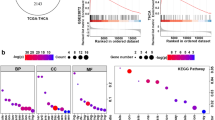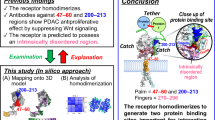Abstract
Paired box 8 (PAX8)–peroxisome proliferator-activated receptor γ (PPARγ) rearrangement is believed to play an important role in tumorigenesis of PAX8–PPARγ fusion protein (PPFP) thyroid carcinomas, while without establishing any standard treatment, including drugs. Although PPFP is a potential promising target for therapeutic agents, the three-dimensional (3D) structure and functions have not yet been experimentally elucidated. In this study, we aimed to construct the 3D structure of PPFP and to aid in the development of therapies that can target PPFP for thyroid carcinomas. The 3D structure of PPFP was constructed by homology modeling based on crystallographic structure data. To validate the modeled structure, we analyzed the thermal fluctuations by molecular dynamics simulations and predicted the physical properties using bioinformatic analyses. We found that the modeled structure was stable under hydrated conditions and had features indicating the actual existence of the structure. Furthermore, the binding free energies of the ligand rosiglitazone with PPARγ and PPFP were evaluated by the molecular mechanics-Poisson–Boltzmann surface area method. We found that rosiglitazone has different binding affinities for the same binding pockets of PPARγ and PPFP, and the optimal compound for PPFP can differ from that of PPARγ. This suggests the need for the development of drugs targeting PPFP that allow for the fusion, rather than focusing on the PPARγ side of PPFP and searching for the best compounds for that pocket. Our findings are expected to lead to the development of new therapies for thyroid tumors.











Similar content being viewed by others
Availability of data and materials
All data generated during this study are included in this published article.
Code availability
Molecular Operating Environment (MOE) version 2018.01 and AMBER 16 package are commercially available. I-TASSER, GOR, ProtParam, Phyre2, and ProSA are freely available on the internet.
References
Cancer Information Service, National Cancer Center J (2020) Projected cancer statistics. https://ganjoho.jp/en/public/statistics/short_pred.html
Haugen BR, Alexander EK, Bible KC et al (2016) 2015 American thyroid association management guidelines for adult patients with thyroid nodules and differentiated thyroid cancer: the American Thyroid Association guidelines task force on thyroid nodules and differentiated thyroid cancer. Thyroid 26:1–133. https://doi.org/10.1089/thy.2015.0020
Ito Y, Onoda N, Okamoto T (2020) The revised clinical practice guidelines on the management of thyroid tumors by the Japan associations of endocrine surgeons: core questions and recommendations for treatments of thyroid cancer. Endocr J. https://doi.org/10.1507/endocrj.EJ20-0025
Klemke M, Drieschner N, Laabs A et al (2011) On the prevalence of the PAX8-PPARG fusion resulting from the chromosomal translocation t(2;3)(q13;p25) in adenomas of the thyroid. Cancer Genet 204:334–339. https://doi.org/10.1016/j.cancergen.2011.05.001
Wells SA, Robinson BG, Gagel RF et al (2012) Vandetanib in patients with locally advanced or metastatic medullary thyroid cancer: a randomized, double-blind phase III Trial. J Clin Oncol 30:134–141. https://doi.org/10.1200/JCO.2011.35.5040
Schlumberger M, Tahara M, Wirth LJ et al (2015) Lenvatinib versus placebo in radioiodine-refractory thyroid cancer. N Engl J Med 372:621–630. https://doi.org/10.1056/NEJMoa1406470
Brose MS, Nutting CM, Jarzab B et al (2014) Sorafenib in radioactive iodine-refractory, locally advanced or metastatic differentiated thyroid cancer: a randomised, double-blind, phase 3 trial. Lancet 384:319–328. https://doi.org/10.1016/S0140-6736(14)60421-9
Kroll TG (2000) PAX8-PPARgamma 1 fusion in oncogene human thyroid carcinoma. Science 289:1357–1360. https://doi.org/10.1126/science.289.5483.1357
Blake JA, Ziman MR (2014) Pax genes: regulators of lineage specification and progenitor cell maintenance. Development 141:737–751. https://doi.org/10.1242/dev.091785
Pasca di Magliano M, Di Lauro R, Zannini M (2000) Pax8 has a key role in thyroid cell differentiation. Proc Natl Acad Sci USA 97:13144–13149. https://doi.org/10.1073/pnas.240336397
Rosen ED, Sarraf P, Troy AE et al (1999) PPARγ is required for the differentiation of adipose tissue in vivo and in vitro. Mol Cell 4:611–617. https://doi.org/10.1016/S1097-2765(00)80211-7
Yamauchi T, Kamon J, Waki H et al (2001) The mechanisms by which both heterozygous peroxisome proliferator-activated receptor γ (PPARγ) deficiency and PPARγ agonist improve insulin resistance. J Biol Chem 276:41245–41254. https://doi.org/10.1074/jbc.M103241200
Patel L, Pass I, Coxon P et al (2001) Tumor suppressor and anti-inflammatory actions of PPARγ agonists are mediated via upregulation of PTEN. Curr Biol 11:764–768. https://doi.org/10.1016/S0960-9822(01)00225-1
Giordano TJ (2006) Delineation, functional validation, and bioinformatic evaluation of gene expression in thyroid follicular carcinomas with the pax8-pparg translocation. Clin Cancer Res 12:1983–1993. https://doi.org/10.1158/1078-0432.CCR-05-2039
Prete A, Borges de Souza P, Censi S et al (2020) Update on fundamental mechanisms of thyroid cancer. Front Endocrinol (Lausanne) 11:1–10. https://doi.org/10.3389/fendo.2020.00102
Dobson ME, Diallo-Krou E, Grachtchouk V et al (2011) Pioglitazone induces a proadipogenic antitumor response in mice with PAX8-PPARγ fusion protein thyroid carcinoma. Endocrinology 152:4455–4465. https://doi.org/10.1210/en.2011-1178
Xu B, O’Donnell M, O’Donnell J et al (2016) Adipogenic differentiation of thyroid cancer cells through the Pax8-PPARγ fusion protein is regulated by thyroid transcription factor 1 (TTF-1). J Biol Chem 291:19274–19286. https://doi.org/10.1074/jbc.M116.740324
Chen N, Schill RL, O’Donnell M et al (2019) The transcription factor NKX1-2 promotes adipogenesis and may contribute to a balance between adipocyte and osteoblast differentiation. J Biol Chem 294:18408–18420. https://doi.org/10.1074/jbc.RA119.007967
Giordano TJ, Haugen BR, Sherman SI et al (2018) Pioglitazone therapy of PAX8-PPARγ fusion protein thyroid carcinoma. J Clin Endocrinol Metab 103:1277–1281. https://doi.org/10.1210/jc.2017-02533
Yang J, Yan R, Roy A et al (2015) The I-TASSER Suite: protein structure and function prediction. Nat Methods 12:7–8. https://doi.org/10.1038/nmeth.3213
Baker D (2001) Protein structure prediction and structural genomics. Science 294:93–96. https://doi.org/10.1126/science.1065659
Shamriz S, Ofoghi H (2016) Design, structure prediction and molecular dynamics simulation of a fusion construct containing malaria pre-erythrocytic vaccine candidate, PfCelTOS, and human interleukin 2 as adjuvant. BMC Bioinf 17:71. https://doi.org/10.1186/s12859-016-0918-8
Bateman A (2019) UniProt: a worldwide hub of protein knowledge. Nucleic Acids Res 47:D506–D515. https://doi.org/10.1093/nar/gky1049
Raman P, Koenig RJ (2014) Pax-8-PPAR-γ fusion protein in thyroid carcinoma. Nat Rev Endocrinol 10:616–623. https://doi.org/10.1038/nrendo.2014.115
Vuttariello E, Biffali E, Pannone R et al (2018) Rapid methods to create a positive control and identify the PAX8/PPARγ rearrangement in FNA thyroid samples by molecular biology. Oncotarget 9:19255–19262. https://doi.org/10.18632/oncotarget.24995
Sievers F, Wilm A, Dineen D et al (2011) Fast, scalable generation of high-quality protein multiple sequence alignments using Clustal Omega. Mol Syst Biol 7:539. https://doi.org/10.1038/msb.2011.75
Garnier J, Gibrat J-F, Robson B (1996) [32] GOR method for predicting protein secondary structure from amino acid sequence. Methods Enzymol 66:540–553
Molecular operating environment (MOE), version 2018.01. Chem. Comput. Gr. ULC, Montreal, QC, Canada (2018)
Case DA, Betz RM, Cerutti DS et al (2016) Amber 2016. University of California, San Francisco
Maier JA, Martinez C, Kasavajhala K et al (2015) ff14SB: improving the accuracy of protein side chain and backbone parameters from ff99SB. J Chem Theory Comput 11:3696–3713. https://doi.org/10.1021/acs.jctc.5b00255
Zgarbová M, Šponer J, Otyepka M et al (2015) Refinement of the sugar–phosphate backbone torsion beta for amber force fields improves the description of Z- and B-DNA. J Chem Theory Comput 11:5723–5736. https://doi.org/10.1021/acs.jctc.5b00716
Wang J, Wolf RM, Caldwell JW et al (2004) Development and testing of a general amber force field. J Comput Chem 25:1157–1174. https://doi.org/10.1002/jcc.20035
Jakalian A, Bush BL, Jack DB, Bayly CI (2000) Fast, efficient generation of high-quality atomic charges. AM1-BCC model: I. Method. J Comput Chem 21:132–146. https://doi.org/10.1002/(SICI)1096-987X(20000130)21:2%3c132::AID-JCC5%3e3.0.CO;2-P
Pang YP (2001) Successful molecular dynamics simulation of two zinc complexes bridged by a hydroxide in phosphotriesterase using the cationic dummy atom method. Proteins Struct Funct Genet. https://doi.org/10.1002/prot.1138
Jorgensen WL, Chandrasekhar J, Madura JD et al (1983) Comparison of simple potential functions for simulating liquid water. J Chem Phys. https://doi.org/10.1063/1.445869
Ryckaert J-P, Ciccotti G, Berendsen HJC (1977) Numerical integration of the Cartesian equations of motion of a system with constraints: molecular dynamics of n-alkanes. J Comput Phys 23:327–341. https://doi.org/10.1016/0021-9991(77)90098-5
Darden T, York D, Pedersen L (1993) Particle mesh Ewald: an N ⋅log(N) method for Ewald sums in large systems. J Chem Phys 98:10089–10092. https://doi.org/10.1063/1.464397
Ester M, Kriegel H-P, Sander J, Xu X (1996) A density-based algorithm for discovering clusters in large spatial databases with noise. In: Proceedings of the 2nd international conference on knowledge discovery and data mining
Gasteiger E, Hoogland C, Gattiker A et al (2005) The proteomics protocols handbook. Humana Press, Totowa, NJ
Kelley LA, Mezulis S, Yates CM et al (2015) The Phyre2 web portal for protein modeling, prediction and analysis. Nat Protoc 10:845–858. https://doi.org/10.1038/nprot.2015.053
Miller BR, McGee TD, Swails JM et al (2012) MMPBSA.py: an efficient program for end-state free energy calculations. J Chem Theory Comput 8:3314–3321. https://doi.org/10.1021/ct300418h
Kabsch W, Sander C (1983) Dictionary of protein secondary structure: pattern recognition of hydrogen-bonded and geometrical features. Biopolymers. https://doi.org/10.1002/bip.360221211
Wiederstein M, Sippl MJ (2007) ProSA-web: interactive web service for the recognition of errors in three-dimensional structures of proteins. Nucleic Acids Res 35:W407–W410. https://doi.org/10.1093/nar/gkm290
Acknowledgements
ST would like to acknowledge the Grants-in-Aid for Scientific Research (Nos. 17H06353 and 18K03825) from the Ministry of Education, Culture, Sports, Science and Technology (MEXT), Japan.
Funding
This work is funded by the Grants-in-Aid for Scientific Research (Nos. 17H06353 and 18K03825) from the Ministry of Education, Culture, Sports, Science and Technology (MEXT), Japan.
Author information
Authors and Affiliations
Contributions
KS, YO and ST designed the research. KS performed the modeling and simulations. KS, YO and ST analyzed the results. KS wrote the manuscript under the supervision of YO and ST. All the authors reviewed and approved the final manuscript.
Corresponding authors
Ethics declarations
Conflict of interest
The authors declare that they have no competing interests.
Additional information
Publisher's Note
Springer Nature remains neutral with regard to jurisdictional claims in published maps and institutional affiliations.
Supplementary Information
Below is the link to the electronic supplementary material.
Rights and permissions
About this article
Cite this article
Sakaguchi, K., Okiyama, Y. & Tanaka, S. In silico modeling of PAX8–PPARγ fusion protein in thyroid carcinoma: influence of structural perturbation by fusion on ligand-binding affinity. J Comput Aided Mol Des 35, 629–642 (2021). https://doi.org/10.1007/s10822-021-00381-x
Received:
Accepted:
Published:
Issue Date:
DOI: https://doi.org/10.1007/s10822-021-00381-x




